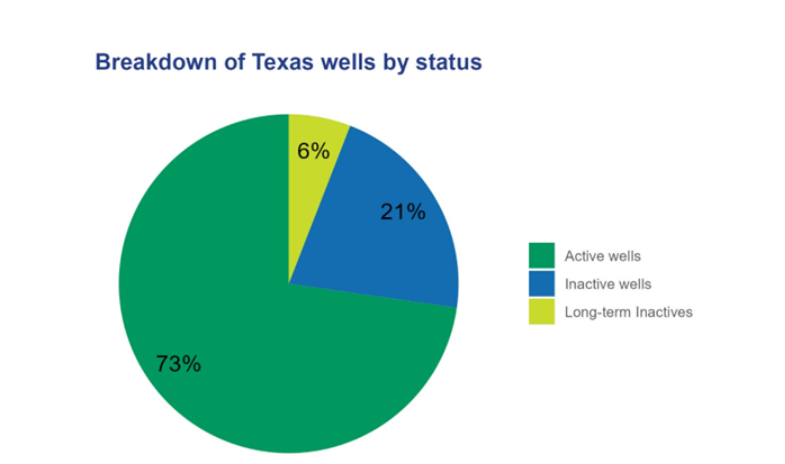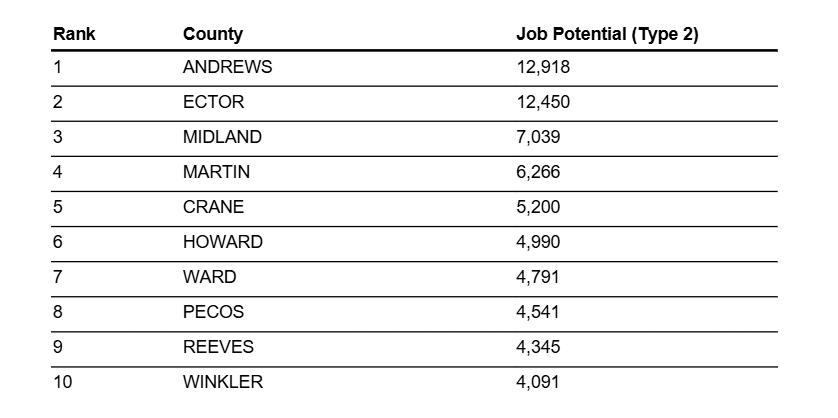This post was co-authored by Environmental Defense Fund economist Luis Fernández Intriago and Senior Manager of Economics and Policy Analysis on EDF’s Economics team Maureen Lackner.
Texas has a huge problem with inactive oil and gas wells. Inactive wells account for 21% of all wells in the state and represent a potentially enormous $15.5 billion plugging cost for taxpayers. If left unplugged, these wells threaten the health and safety of Texas landowners and the industry itself.
The good news: Fixing this problem can create lots of jobs! Plugging Texas’ existing orphans and inactive production wells could generate as many as 84,000 direct and indirect and 68,000 induced jobs across the state.
- Spreading this spending over 10 years would create a steady source of jobs, translating to a roughly 6% increase in employment for the sector over the next decade.
- Spending money to plug these wells would generate $13.1 billion ($19.2 billion when including induced jobs) to Texas’s GDP.
Two companion bills working their way through the Texas legislature present a big opportunity for a triple win to create jobs, improve people’s health, and protect the state and local economy.
Texas Senate Bill 1150 and companion House Bill 2766 mark an important first step in addressing an urgent and growing problem for Texans: unplugged, long-term inactive oil and gas wells. The bills encourages oil and gas companies to plug inactive wells that were drilled over 25 years ago and have been inactive for more than 15 years–alleviating risks to human health, natural resources and state finances. Leaving these inactive oil wells unplugged could risk the integrity of Texas’ oil and gas reservoirs, and could ultimately cost taxpayers money if the wells eventually become orphaned.
However, while we applaud efforts of SB 1150 and HB 2766 to hold operators accountable to their longstanding legal obligations to plug their non-productive wells, we estimate that the bills would target less than 25% of the state’s current inactive wells. With modest changes, these bills could be strengthened to better prevent wells from becoming taxpayer burdens and reducing the economic viability of the geology of Texas.
As the legislation evolves, we want to highlight for policy makers an economic benefit of plugging non-producing oil and gas wells: job creation. Our analysis shows that plugging 112,100 of Texas’ existing orphans and inactive production wells could generate as many as 84,000 direct and indirect and 68,000 induced jobs across the state.
Counting the inactive wells in Texas
Recent data from the Texas Railroad Commission (RRC) shows that Texas is home to roughly 380,000 unplugged wells owned by solvent operators. While many of these wells are producing oil and gas, a large share of them have likely reached the end of their economic lifespan. Our analysis of RRC data finds that about 103,600 wells (27% of all wells) are tagged as “inactive,” indicating that they are not currently producing. About 22,400 inactive wells (6% of total, 22% of inactive wells) have been inactive for 15 years or longer.
Many of these wells will never return to production. EDF analysis of a cohort of Texas’s inactive wells finds that, historically, only 23% of inactive wells reactivate after even just 5 years of inactivity. After 15 years inactivity, just 6% typically reactivate.
Share of Wells that Remain Inactive
Avoiding orphan wells to protect health, property values and the taxpayers’ dime
The longer inactive wells are allowed to sit idle, the more likely it is that they join the ranks of Texas’s 8,500 orphan wells. Orphan wells are oil and gas wells without a solvent owner (usually a result of bankruptcy). As such, the state must take on the expensive task of plugging and remediating the well site. Unplugged wells can act as conduits from subsurface oil and gas reservoirs, which are highly corrosive environments, to groundwater resources and the surface. If not maintained, well infrastructure can corrode, lose structural integrity and become avenues for leaking hydrocarbons and brines. These substances can contaminate groundwater and surface waters, leak hazardous liquid and gases, including carcinogens, and emit greenhouse gases such as methane. In addition to causing health and environmental hazards, they lower property values and reduce the viability of the geology for other uses, including geothermal and carbon storage but also further oil and gas production.
While properly plugging and abandoning these wells is not free, it is far more costly to deal with emergency blowouts and clean up contaminated water and soil caused by improperly abandoned wells. Plugging wells before they are orphaned not only creates jobs, but it also prevents a much more costly clean-up down the road.
Well Plugging and Job Creation in Texas
We rely on the Bureau of Economic Analysis’ Regional-Input-Output Modeling System (RIMS II) to estimate job creation. Input-output models allow economists to estimate the indirect, direct, and induced effects associated with an increase or decrease in spending across a sector or industry. Our methods follow the steps outlined in detail in this economic analysis.
Our spending estimate is based on the total responsibility or cost associated with plugging Texas’s orphan and inactive wells. Our well data comes from the Texas RRC, which catalogs both existing orphan wells and inactive wells in the state. In addition, the Texas RRC data provides average per foot plugging costs per well at the oil and gas district level. We multiply this by TX RRC-reported well depths to estimate a per-well plugging cost. The sum of plugging costs across all wells represents the total responsibility or spending needed for the industry.
RRC Well Summary Stats for Job Creation Estimates
When we apply 2022 RIMS II regional multipliers to the total plugging responsibility of $15.5 billion we find that plugging Texas’s current orphaned and idle wells translates to a total of nearly 84,000 direct and indirect and 68,000 induced jobs. Documented orphaned well closure account for the smallest share of jobs at 4,400 direct/indirect jobs. Idle wells account for nearly all jobs – 79,500 direct plus indirect, while long-term idle wells (15 years or longer) account for nearly 14,800 direct and indirect jobs.

Job Creation Estimates by County (by Well Category) Source: Elaborated by EDF with data from The Railroad Commission of Texas (RRC) and BEA’s Regional Input-Output Modeling System (RIMS II)

Total Job Creation Estimates by County (Type 1) Source: Elaborated by EDF with data from The Railroad Commission of Texas (RRC) and BEA’s Regional Input-Output Modeling System (RIMS II)

Total Job Creation Estimates by County (Type 2) Source: Elaborated by EDF with data from The Railroad Commission of Texas (RRC) and BEA’s Regional Input-Output Modeling System (RIMS II)
These jobs would be generated across the state. Our analysis shows that 230 of Texas’s 254 counties (91%) have wells that need to be plugged. Assuming that these jobs are generated in the counties where the wells are, we find that a median of 120 direct/indirect jobs and about 100 induced jobs could be expected for any given county. Counties with a very high share of orphan and inactive wells, could experience a much higher number of jobs. For example, Andrews and Ector Counties in the Permian Basin would generate about 7,000 direct/indirect jobs and over 5,500 induced jobs each to plug their relatively high share of wells.
Top 10 Counties by Total Job Creation Potential
Source: Environmental Defense Fund 2025
Putting job creation into context for the industry
To put the Type I job numbers into context, we looked at data from the Bureau of Labor Statistics. The BLS Quarterly Census of Employment and Wages shows that the 2024 average Texas employment numbers for the oil and gas sector are about 134,000 jobs. Assuming wells are plugged over 10 years, this would translate to a roughly 6% increase in employment for the sector over the next decade.
In addition, we find that plugging all current future utility wells would generate $6.5 billion ($9.1 billion when extending to induced jobs, Type II multipliers) in earnings and $13.1 billion ($19.2 billion when including induced jobs) to Texas’s GDP. When compared to the estimated plugging costs of $15.5 billion, our analysis suggests potential for a positive economic return on investment, especially when considering unquantified benefits such as increased property values, enhanced usability of the geology, avoided remediation costs, and public health improvements. While the exact economic return is sensitive to discount rates and implementation timelines, the substantial job creation and economic activity generated by this initiative represent benefits for Texas communities.
Economic impacts associated with plugging all orphaned and idle wells
Addressing Texas’ inactive well problem has been years in the making and it will take time and resources to bring the situation under control. While this challenge will present hurdles for the industry, tackling this problem is also an opportunity for large-scale job creation for industry and the counties that support it, in addition to other economic, public health and environmental benefits that come from plugging end-of-life wells. As all stakeholders acknowledge – industry, regulators, policymakers, landowners, and many others–it’s time to get moving on closing these non-productive wells and put Texans to work now.














